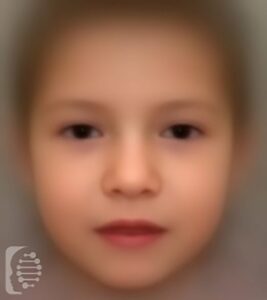What is 22q11.2 Deletion syndrome?
22q11.2 Deletion syndrome, or as it is sometimes referred to, DiGeorge syndrome, is a genetic disorder. It is often referred to by several different names and presents with a wide range of symptoms that can affect almost any part of the body. The characteristics and symptoms of the syndrome vary greatly between individuals and even amongst individuals with the same syndrome.
This syndrome is also known as:
CATCH 22 Chromosome 22q11.2 – microdeletion Chromosome; 22q11.2 deletion syndrome; Conotruncal anomaly-facies syndrome; Conotruncalanomalyfaciessyndrome; DiGeorge syndrome; DGS Hypoplasia Of Thymus And Parathyroids Sedlackova syndrome; Shprintzen syndrome; Shprintzen VCF Syndrome Takao syndrome; Takaosyndrome Third And Fourth Pharyngeal Pouch Syndrome; Velocardiofacial Syndrome
What gene change causes 22q11.2 Deletion syndrome?
22q11.2 Deletion syndrome occurs due to the deletion of DNA base pairs on chromosome 22. Known as a contiguous gene deletion syndrome, researchers are currently identifying the specific gene deletions that contribute to each of the syndrome’s various symptoms.
Microdeletion inheritance occurs when there is a deletion of several genes on a chromosome. The specific chromosome on which the deletions occur will determine the syndrome they cause.
1 in every 4,000 live births in the US will present with 22q11.2 deletion syndrome, and most cases are the first in a family. In 1 in 10 cases, one parent will pass the deletion to their child.
Genes, locations, and inheritance modes
COMT, 22q11.21 – Autosomal Dominant
SEC24C, 10q22.2 – Autosomal Dominant
ARVCF, 22q11.21 – Autosomal Dominant
JMJD1C, 10q21.3 – Autosomal Dominant
DGCR6, 22q11.21 – Autosomal Dominant
FGF8, 10q24.32 – Autosomal Dominant
ESS2, 22q11.21 – Autosomal Dominant
DGCR8, 22q11.21 – Autosomal Dominant
HIRA, 22q11.21 – Autosomal Dominant
RREB1, 6p24.3 – Autosomal Dominant
CRKL, 22q11.21 – Autosomal Dominant
DGCR2, 22q11.21 – Autosomal Dominant
TBX1, 22q11.21 – Autosomal Dominant
GP1BB, 22q11.21 – Autosomal Dominant
Listed genes may or may not be included in all cases, different genes contribute to different characteristics.
What are the main symptoms of 22q11.2 Deletion syndrome?
22q11.2 deletion syndrome and DiGeorge syndrome represent a spectrum of syndromes that share congenital heart defects, immunological abnormalities, and variable facial features.
The main symptoms of 22q11.2 deletion syndrome can vary significantly between individuals. Congenital heart defects are a common feature of the syndrome. Other health conditions include cleft palate, feeding issues, gastrointestinal problems, problems with the immune system and resultant infections, low levels of calcium in the blood and related health conditions, ENT issues, and missing or damaged kidneys.
Mental health conditions associated with 22q11.2 deletion syndrome include increased risk for OCD, autism, ADD, and delays in growth, speech, and the potential for learning disabilities. Behavioral and developmental delays are common.
Possible clinical traits/features:
Underdeveloped nasal alae, Hypocalcemia, Nasal speech, Impaired T cell function, Short stature, Velopharyngeal insufficiency, Retrognathia, Open mouth, Pierre-Robin sequence, Autosomal dominant inheritance, Right aortic arch with mirror image branching, Recurrent infections, Unilateral primary pulmonary dysgenesis, Retinal vascular tortuosity, Microcephaly, Umbilical hernia, Ventricular septal defect, Tetralogy of Fallot, Posterior embryotoxon, Aggressive behavior, Cleft palate, Blepharophimosis, Bulbous nose, Abnormality of the endocrine system, Abnormality of the ear, Abnormality of the hand, Mood swings, Muscular hypotonia, Inguinal hernia, Intellectual disability, Specific learning disability, Paranoia.
How is it diagnosed?
To find out if someone has a diagnosis of 22q11.2 Deletion Syndrome, it is important to have a consultation and evaluation with a clinical genetic specialist. Specialists may also suggest specific genetic testing or other types of tests to help reach a diagnosis. FDNA’s AI technology can help speed up the diagnostic process by analyzing facial features and other health information.


